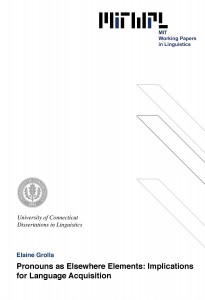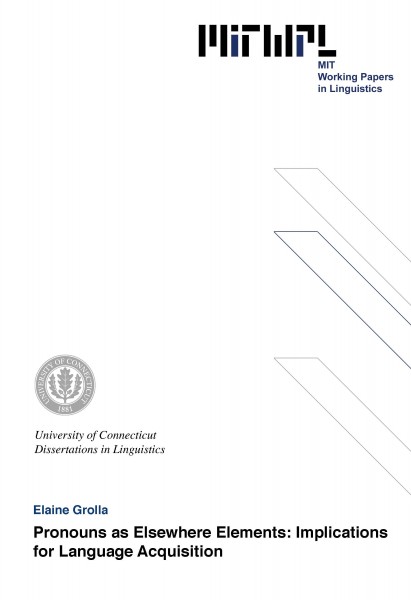Pronouns as Elsewhere Elements: Implications for Language Acquisition
E. Grolla, 2005
Abstract
This dissertation investigates the acquisition of A- and A –bound pronouns in Brazilian Portuguese and English. Previous studies on the acquisition of pronouns have found that children behave at chance level when pronouns with local antecedents in A and A positions are tested.
The hypothesis under investigation here is that children performed poorly in tests with locally A- and A-bound pronouns because the source of the problem is the same. There are several reasons to pursue a unifying approach. First, both constructions involve pronouns. Second, results of studies in several languages indicate that children perform similarly on both tests, incorrectly accepting these cases at chance level. And third, the age-range when this chance performance is detected is the same in both cases, that is, around 4 and 5 years of age.
Following Hornstein (2001), I assume that (A- and A-) bound pronouns are elsewhere elements, that can only be inserted in a derivation if needed for convergence. Adopting Grodzinsky and Reinharts (1993) hypothesis, I claim that such a condition is too demanding for young children, as their limited working memory cannot handle complex computations, such as those required in order to assess if bound pronouns are licit in a derivation.
Using the grammaticality judgment task, the same Brazilian Portuguese- and English-speaking children were interviewed on two experiments, one involving A-bound pronouns and another involving A-bound pronouns. The date revealed that the majority of the children performed at chance level (50% correct responses) when A- bound pronouns placed in extractable positions were tested (*the frog that he is skating is happy). Children also behaved at chance level when pronouns locally A-bound by both referential and quantified antecedents were tested (*the dog √every dogi is scratching himi). Importantly, children did not behave at chance in control cases where the kind of computation mentioned above is not necessary. In these cases, children behaved at ceiling. These results support the hypothesis under investigation here, indicating that childrens problems with pronouns is related to processing problems rather than to the lack of some linguistic knowledge.
Table of Contents
Chapter 1- Introduction 1
1.1. Introduction 1
1.1.1 Language Acquisition and the Theory of Principles and Parameters 1
1.1.2 A-Bound Pronouns in Adult Languages 3
1.1.3 A-Bound Pronouns in Adult Languages 5
1.2. The Acquisition of Pronouns 7
1.2.1 The Acquisition of A-Bound Pronouns 7
1.2.2 The Acquisition of A-Bound Pronouns 10
1.2.3 Proposal 11
Chapter II –Previous Studies 22
2.1 Studies on the Acquisition of A-Bound Pronouns 23
2.1.1 Chien and Wexler (1990) 25
2.1.2 Thornton and Wexler (1999) 33
2.1.3 Grodzinsky and Reinhart (1993) 42
2.1.4 Conclusion 47
2.2 Studies on the Acquisition of A-Bound Pronouns 47
2.2.1 Labelle (1988, 1990) 54
2.2.2 Prex-Leroux (1995) 57
2.2.3 McKee and McDaniel (2001) 63
2.2.4 Conclusion 68
2.3 Conclusion to Chapter 2 69
Chapter III- The Acquisition of A- and A-Bound Pronouns 70
3.1 Introduction 70
3.2 Pronouns as Elsewhere Elements 72
3.2.1 Pronouns in Brazilian Portuguese 81
3.2.2 Technical Implementations 84
3.2.2.1 The Insertion of Self 84
3.2.2.2 The Insertion of Pronouns 87
3.2.2.3 Coreferential Pronouns 90
3.2.3 Reference-Set Computation 94
3.3 Reference-Set Computation and Working Memory 96
3.3.1 Reference-Set Computation and Language Processing 97
3.3.2 Working Memory Capacity in Children and Adults 101
3.4 Proposal and Predictions 104
Chapter IV- Experimental Results 110
4.1 Introduction 110
4.2 Experiments 112
4.2.1 Experiment I: English 112
4.2.2 Experiment II: Brazilian Portuguese 125
4.3 General Discussion 130
4.3.1 Chance Level Performance 130
4.3.2 Reaching the Steady State 133
4.3.3 Avrutin and Wexler (1992) on the Acquisition of Russian 135
4.4 Quantified Antecedents 138
4.4.1 DP – him vs. QP – him Acceptance Rates 139
4.4.2 Chien and Wexler (1990) 141
4.4.2.1 Experiment III: The Saliency Test 148
4.4.3 Thornton and Wexler (1990) 154
4.4.4 Conclusion 157
4.5 Conclusion to Chapter 4 158
Chapter 4 –Final Remarks 160
5.1 Introduction 160
5.2 The Acquisition of Bound Pronouns 160
5.3 The Elimination of Principle B from the Theory of Grammar 165
5.4 Implications for Future Research 172
Appendix I – Sentences Used in Experiment I (English) 180
Appendix II – Sentences Used in Experiment II (Brazilian Portuguese) 181
Appendix III – Sentences Used in Experiment III (Saliency Test) 183
References 184

